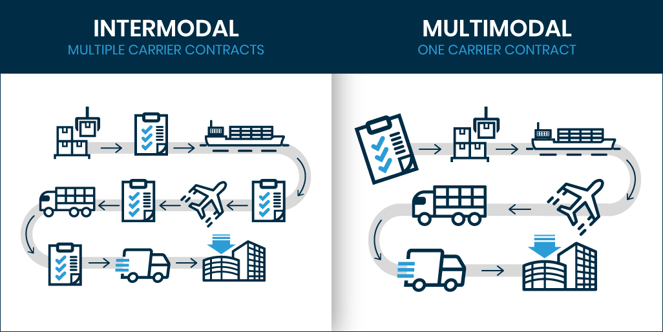Unlock Success With Auto Dispatching: 5 Powerful Benefits For Your Operations
Logistics can get complex quickly, especially if you're not employing any automation tools. Shippers today need every advantage to increase...

Intermodal transportation typically saves you 10-15%; however, it is more complicated than direct shipping. There are differences to be aware of and prepare for to save successfully.
Let's be clear on some differentiators when shipping across multiple modes. When transport travels over various modes, rail and truck are typical examples, under multiple carrier contracts, that is known as intermodal shipping. Multimodal is when shipments fall under one carrier contract from mode to mode.
The various potential modes include trucks, trains, boats, and planes–with undoubtedly drones soon to be commonplace on the last mile of delivery on lighter shipments.

Intermodal transportation allows you to save money in two specific ways:
GUIDE: Digital Connectivity For Freight & Shippers
The primary benefits of using multimodal are it removes the hassle and time involved in organizing multiple contacts. A multimodal transport operator (MTO) takes on the responsibility and liability of your shipment throughout its journey.
If saving money is your primary focus, investigating intermodal options is a good idea. Here are a few other characteristics that make your shipment a solid candidate for intermodal:
When deciding on trucks vs. intermodal, you should consider the overall cost of the modes and not base it strictly on a cost per mile quote. Keep in mind that intermodal is more likely to go out of route and incur more mileage than trucks. You will need to take into account all the modes that travel as one holistic cost and compare it to OTR options.
A Guide to Digitizing Logistical Supply Chains
As noted earlier, intermodal containers have unique weight factors. According to Global Trade Magazine, the top issue new intermodal shippers encounter is not understanding the weight and distribution of intermodal loads. Do keep in mind that your bill of lading needs to be 42,500lbs or less to reduce the risk of being overweight.
Intermodal containers are also more rigid, allowing them to be stacked. The onus for blocking and bracing cargo is generally on the shipper. Blocking and bracing is critical if your cargo is traveling on rail as rail shipments experience steady, harmonic vibrations that cause unsecured freight to shift. Blocking and bracing are not tricky, and shippers will find railroads helpful in providing direction on how best to secure freight.

The general rule of thumb is intermodal transport takes what a truck would take, plus a day. Particularly with rail, you need to allow more time as rail is prone to detention more than trucks. And you should allow an extra 2-3 days if your freight is traveling via rail over different Class railroads (Class I, II, or III).
So, time-sensitive, temperature-controlled freight is not your best bet on intermodal, but light-weight cargo that does not need to be temperature controlled is. Nation-wide retailers that ship clothes, cereal, and furniture rely heavily on intermodal transport.
Managing Private Trucks and 3PLs
If you ship intermodal and are relying on your team to organize multiple contracts and track the entire shipping journey, you need capable shipping software. Your shipping software, or TMS, should be able to:
We encourage you to check out our TMS capabilities of Expedia-like carrier rate shopping and freight tracking to make intermodal shipments easier for you to manage.
And if you need help with putting together RFPs, access our template below to solicit carrier quotes faster!

Logistics can get complex quickly, especially if you're not employing any automation tools. Shippers today need every advantage to increase...

Every industry has its fair share of pain points. In the shipping and logistics sector, however, an inability to address these challenges can...

Our goal is simple. We want to enable shippers to ship smarter, and ship easier. Please see our extensive FAQs below with resource links and guides...